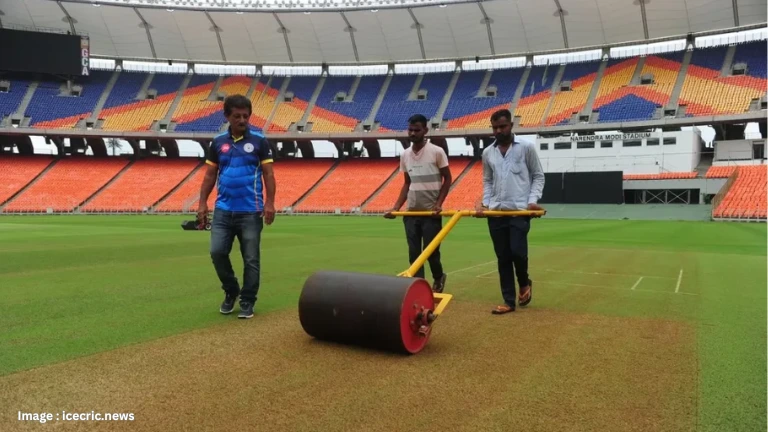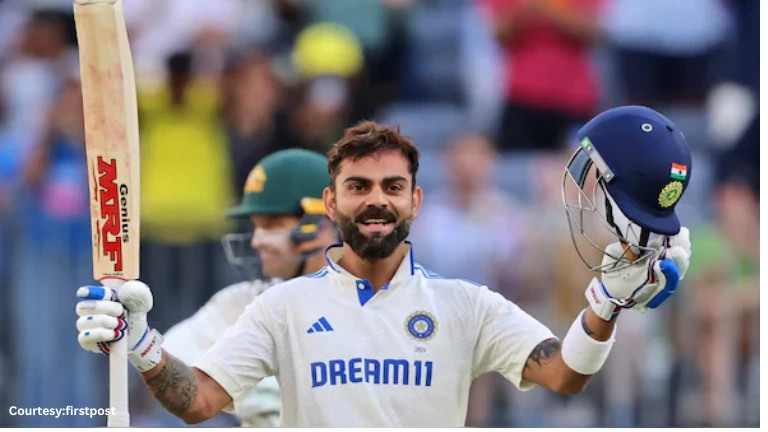Narendra Modi Stadium Pitch Report- When you hear the name “Narendra Modi Stadium,” what’s the first thing that pops in your mind? Probably the size because yes, it is the largest cricket stadium in the world, sitting proudly in Ahmedabad, Gujarat. But beyond the sheer magnitude, the soul of this stadium lies beneath right on the 22-yard strip. The pitch. The same patch of soil that decides whether it’s going to be a six-hitting festival or a spin wizard’s magic show.
So, the big question is the Narendra Modi Stadium pitch a friend of the batsmen or a nightmare cooked up for bowlers?
Let’s dig deep.
A Pitch With Two Faces
One thing you quickly learn about this ground is that it doesn’t have just one personality. Unlike some stadiums that are predictable “Oh, Wankhede means runs, Chennai means spin” Narendra Modi Stadium keeps you guessing.
Why?
Because the stadium has multiple pitches 11 to be exact each prepared with different soil compositions. Some are made of black soil, and some are of red soil. This might seem like boring technical stuff, but believe me, this is the whole twist in the tale.
- Black soil pitches hold moisture longer. That means the pitch slows down as the game goes on, helping spinners and slower bowlers.
- Red soil pitches dry out quicker. These tend to assist fast bowlers early on, but later they become batting paradises.
This dual nature means that what happens in one match might completely flip in the next. That’s why you’ll find some matches ending with 400+ totals and others where teams collapse under 120.
Also Read : Narendra Modi Stadium Guide to Capacity, VIP Seating, Tickets
Batting: Feast or Famine?
Let’s talk about what everyone loves batting. Sixes, fours, and milestones.
Over the years, the Narendra Modi Stadium has seen both extremes. Take the IPL for example. Some matches have seen scores over 200, especially when the pitch is flat and dry. In such cases, batters dominate especially when dew sets in during night games.
One thing’s for sure the outfield is lightning fast, and the ground dimensions, while big, still allow clean hitters to clear the ropes. If the ball comes onto the bat nicely, it’s a joy for batters. Especially players like Shubman Gill, Hardik Pandya, or even visiting stars like Jos Buttler or David Warner they’ve all had their moments under the lights in Ahmedabad.
But and it’s a big but on days when the pitch is tacky or two-paced, even world-class batters struggle. You’ll suddenly see mistimed shots, leading edges, and low strike rates. That’s when the batters have to grind.
Bowling: Not a Bowler’s Graveyard
Now, let’s not write off the bowlers yet. Narendra Modi Stadium is far from being a batting-only venue. In fact, some of the most dominant bowling performances in recent Indian cricket history have come from this very pitch.
Spinners, especially, have loved it. Think back to the India vs England Test series in 2021. Axar Patel and R. Ashwin spun a web around England’s batters, destroying them in just two days. The pitch that time was a turning monster, and England didn’t know what hit them.
Even in white-ball cricket, spinners who vary their pace and length smartly have been able to control the middle overs. Bowlers like Rashid Khan and Kuldeep Yadav have shown that if you’re clever, Narendra Modi Stadium can be your playground.
What about fast bowlers? Interestingly, they also find joy here — but only if the pitch has some grass cover or early morning moisture. In day matches or during early overs, the red soil can offer bounce and movement. Bowlers like Mohammed Shami or even pacers like Josh Hazlewood have had successful outings here.
Day vs Night Matches – The Dew Factor
One major element that affects games here is dew.
During night games, especially in winter months or early summer, dew settles in like an uninvited guest. What this does is makes the ball wet and slippery, taking spin and grip out of the equation. Bowling second becomes a nightmare, and chasing becomes a lot easier.
That’s why captains, especially in T20s and ODIs, almost always choose to bowl first if they win the toss. No team wants to bowl with a soap bar in the second innings.
So, when someone asks is this a batting pitch or a bowling pitch? you now know the answer isn’t black and white. It depends on the time of the game, type of soil, weather, and yes even the toss.
IPL 2023 & 2024: A Mini Recap
Let’s revisit a few examples from recent IPL matches to get a better idea.
- In 2023, during the final between CSK and GT, we saw both teams go past 170 in a rain-affected thriller. The pitch was flat, and the batters had a ball.
- In contrast, in a league stage match, GT bowled out LSG cheaply on a slower surface. The pitch was gripping, and spinners came into play early.
Same ground. Different stories.
Verdict: What Should Fans Expect?
If you’re a fan attending a game at the Narendra Modi Stadium expect anything. That’s the beauty of it.
On some days, it’ll be a run-fest, and the crowd will erupt with every boundary. On others, it will be a bowling masterclass where every wicket brings fans to their feet.
But here’s what’s guaranteed:
- A stadium with electric energy
- A pitch that doesn’t follow just one pattern
- And a match that won’t be boring, no matter who’s playing
Final Thoughts
Narendra Modi Stadium is a perfect example of why cricket is such an unpredictable, fascinating game. You never quite know what’s going to happen on that strip of land. Will the batters light it up with their fireworks? Or will the bowlers script a thrilling collapse?
So next time you tune in to watch a match here don’t just look at the toss. Watch closely. The cracks. The color of the soil. The early movement. The spin. Because in those little signs lies the answer to who’s going to shine.
And that’s what makes cricket at Narendra Modi Stadium so damn addictive.


